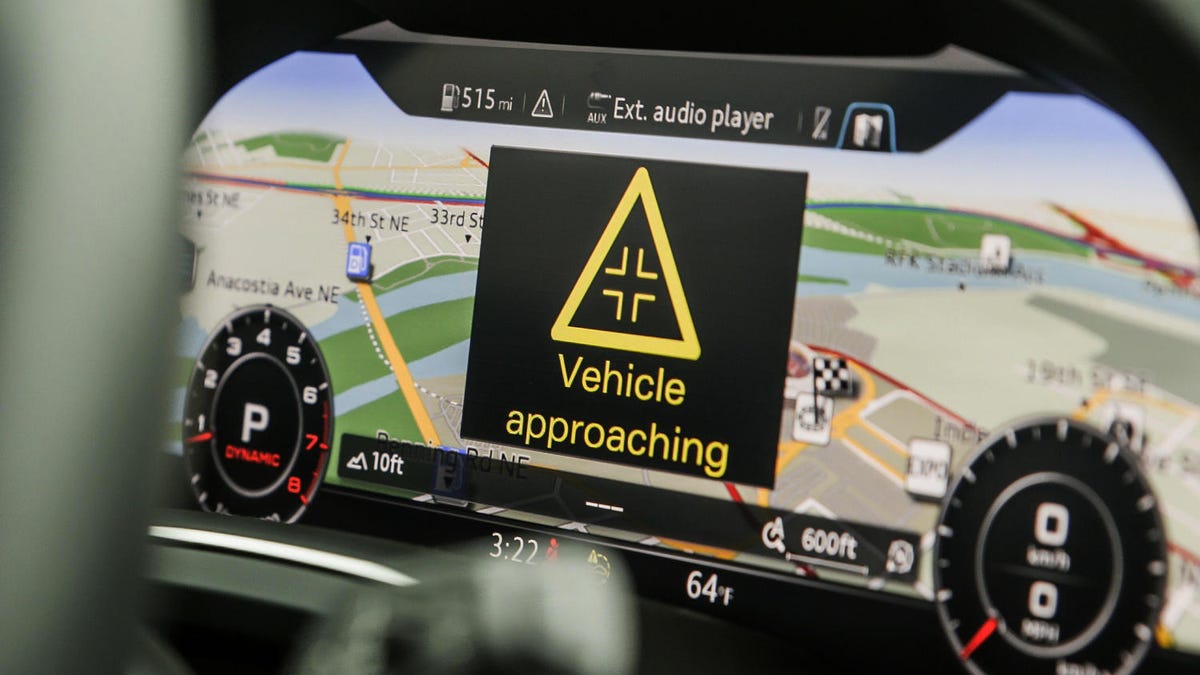Sampling Qualcomm's C-V2X tech in an Audi Q8 at CES 2019
Cellular-based tech promises to make driving safer and easier.

Automakers have been talking about enabling cars to communicate with one another for years, but Qualcomm is now perhaps better poised than ever to actually put the tech into practice. While you won't see it in your new car just yet, I had a chance to try out Qualcomm's C-V2X technology during CES 2019.
C-V2X stands for "cellular vehicle to X," meaning that cars can communicate with not just other cars, but also things like motorcycles , traffic signals and, potentially, even bicycles and pedestrians. Qualcomm's demo consisted of riding in an Audi Q8 around an artificial "city" course laid out in a parking lot. The crux of the challenge was to have four vehicles approach a four-way stop at once: Which car goes first?
The Audi was specifically modified to show these warnings for the demonstration.
In the Q8, an on-screen prompt warns the driver when they're approaching an intersection and advises them to stop. Then, behind the scenes, the C-V2X tech communicates with other vehicles to negotiate which car goes first. For instance, if two opposing cars are both going straight, they can drive away immediately -- whereas someone turning left would be prompted to stop. That will ease traffic congestion with human-driven cars and, of course, would be a boon for autonomous cars.
There are also safety applications. When the rider of a Ducati motorcycle (deliberately) blows the stop sign, the Audi Q8 displays a warning about oncoming traffic. That could prevent accidents before in-car sensors detect a hazard. There's also functionality to warn if a car ahead is braking hard. Even if the car is ahead of a truck, for instance, the following car would receive a warning of the impending stop. Qualcomm's demo even has a setup to keep people safer when they're not in a car. A crosswalk sign transmits a warning over the C-V2X network, prompting the Audi to warn of a pedestrian ahead.
Still, this technology doesn't replace in-car safety features; it supplements it. "Cameras, radar and LIDAR are good, but not sufficient because you still need communications," said Jason L. Ellis, Qualcomm's director of business development for connected car and telematics.
This warning requires that a pedestrian push a button on a C-V2X-equipped crosswalk sign.
Qualcomm's technology uses cellular-style radio communication but not a cellular network. It doesn't need to communicate with a base station or server to make all this magic happen. Instead, the radio runs on an unlicensed 5.9GHz band that has been specifically set aside for transportation use. And because Qualcomm's chip can provide both this C-V2X functionality and traditional telematics -- in-car Wi-Fi, OnStar-like functions, live traffic maps -- the supplier thinks it'll appeal to car manufacturers.
The radios have a range of approximately 1 kilometer (0.6 miles) in ideal circumstances and about half a kilometer in dense urban environments. Most importantly, because there's no cell network to connect to, owners of cars don't need to pay for a data plan to use the C-V2X feature -- unlike, say, keeping a data plan to continue getting map data and Wi-Fi in your late-model car.
See also
Ideally Qualcomm would like to see infrastructure -- traffic lights, crosswalks and so on -- fitted with its chips, too, so those devices could communicate with cars. The supplier announced it's planning to work on a trial system for that here in Las Vegas. Audi and Qualcomm actually demo'd V2I technology like this in Las Vegas several years ago, but Ellis says that setup used older, cellphone data-based connections with more latency.
The big question is, of course, how quickly this technology will spread across the new-car market. (The Audi used in the demo was specifically modified for the trial and had an extra antenna and computer installed for the communications.) Ford said publicly at CES that it would install Qualcomm's chips in all its new cars from 2022. And because the C-V2X feature doesn't necessarily require municipalities to install new infrastructure, it'll work in any city as soon as appropriately equipped cars arrive. But it's clear that the warning system will only be at its most useful when every vehicle on the road has this tech.
Self-driving cars: Stay up to date on all the latest news in autonomy.
CES 2019 schedule: It's six days of jam-packed events. Here's what to expect.

